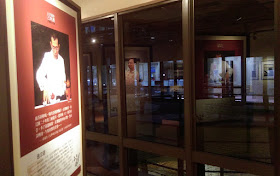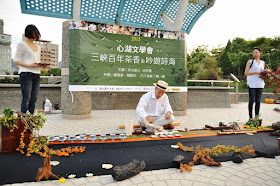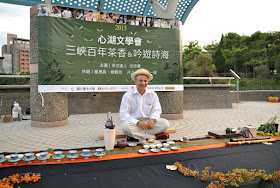The library of the National Taipei University in San Hsia is currently holding an exhibition about Taiwanese authors and artists who have contributed to the cultural life of San Hsia. Teaparker being of them, the university organized a Chaxi event with Teaparker's students and accompanied by Chinese music.
At 3 PM, we arrive on campus and we set up the Chaxi near the Heart Lake.
It's a huge Chaxi, because this outdoors stage is very big! Most of the Chaxi was thought of and set up by my friend Evon. But several students contributed to complete it and make the whole event possible.
I brought the white Nilu, my bamboo basket and the upside down Jianyang black glazed bowl (see above). The presence of the basket (and most objects on the edge of the Chabu) wasn't just aesthetic, it also prevented the wind from blowing the fabric away! The Sung style bowl served the same purpose, but also had a conceptual meaning: since we were going to use Yuan dynasty style cups, the upside down bowl would represent the overthrown Sung dynasty preceding the Mongols (Yuan).
My good friend John helped prepare the water and feed the Nilu with charcoal. (I also thank him for taking the pictures of myself at the end of this post). We would even take turns to brew, making this event a team effort!
For this special occasion, Teaparker chose 2 green teas connected to San Hsia's tea culture. This is why we used silver teapots and rather big cups for both teas.
This university sponsored tea event is a great reminder of the connection between tea, culture, history and arts. The word 'university' also makes me think of how tea is 'universal'. Each Chinese dynasty has created its own tea culture. Even different countries have their own rituals. Tea has no boundaries. On the contrary, tea is freedom and what you want to make out of it.
This is the approach that suits me best. First, learning about the classics and then turning the tea experience into a creative process. The Chaxi is a playground for tea lovers. Everybody was taking pictures!
Red leaves for an autumn feeling.
Tea can be connected to almost any subject. Sometimes, it's like meditation.
Or it's connected to history: San Hsia started to make green tea at the request of generals of Chiang Kai Shek's army who had retreated to Taiwan and couldn't purchase their tea in Hangzhou anymore. The local qingxin Ganzhong was very suitable for green tea and San Hsia farmers started to make their own Longjing and BiLuoChun in the 1950s!
After the speeches, we had the privilege of hearing a concert of traditional Chinese music that put us in a relaxed and happy mood, ready to enjoy tea! Enjoy a few moments with this short video:
You may be wondering why we would be brewing green tea that is a decade old. The reason is simple and is at the very heart of all our tea pursuit: because it still tastes delicious!
Good, dry storage and top quality are the key points. The finest pleasure then comes from finding freshness within these ancient aromas.
The tea I'm brewing is even older. It's a SanHsia Longjing from the 1970s! These are the last leaves from Teaparker's stash of this tea. It's an honor and privilege to brew them for our attendees and to have 2 pretty tea friends helping me with the service.
That's why you see me dressed up, but not wearing a costume. Even when we are performing in front of an audience, we wish to show that brewing tea with style and technique is rooted in our daily life. No need to wear a certain style of clothes. Just feel comfortable and elegant would be my advice.
Since we are outdoors and can't wash the cups and teapot properly, we decided to use a different tea set for this second tea. A silver teapot, plated with gold, Dehua porcelain dragon cups and silver cha tuo.
The smell of the tea is sufficient to trigger salivation in the back of my mouth! It seems to dance with freshness and warmth, a little bit like this day of October. It's difficult to describe the complexity of these contradictory, but pleasant aromas.
This difficulty in describing this intense pleasure of such a tea experience creates a mystery and a space for your imagination. This may lead to poetry, creativity or even spirituality. "What you do with tea is different for everybody", I remember a tea friend saying to me recently. It's rooted in culture, traditions, education.
What doesn't change is the search for quality leaves and brewing them the best possible way. This is how a partial cloudy autumn afternoon in San Hsia can turn into a tea event seen and discussed worldwide. Tea knows no borders. Tea is universal.






















This looks like an amazing event -wish I could have been there! I have a question about the longjing you brewed. How noticeably different is San Hsia Longjing from Hangzhou Longjing in flavor and appearance? Would there be an easy way to recognize the difference? Also, do you happen to know the storage Teaparker used for these teas?
ReplyDeleteThanks Ryan. You would have felt at home in this university! The San Hsia Longjing has a larger leaf than Longjing in Xihu. The aromas are very different. Since you've already had top quality Hangzhou Longjing, you would have no trouble to taste the difference!
ReplyDelete